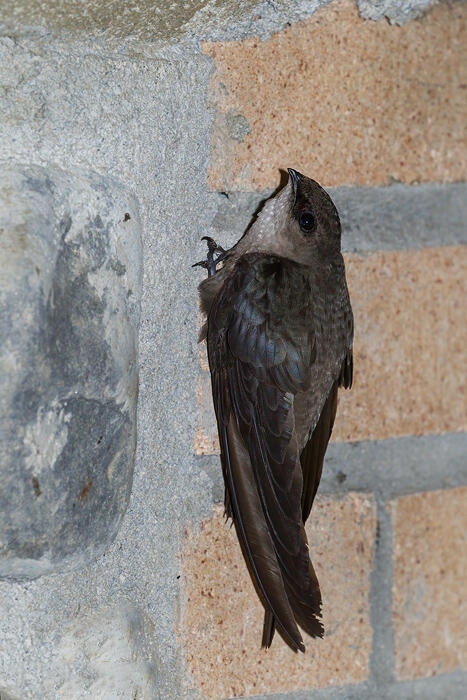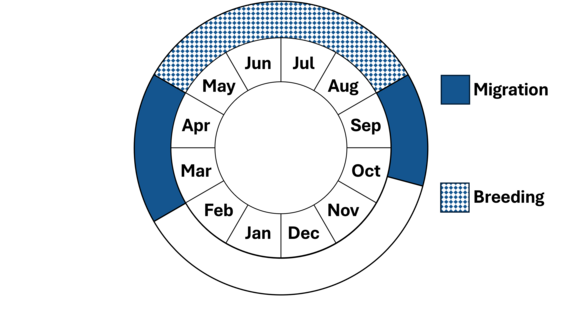- Scientific name: Chaetura pelagica
- Species of Greatest Conservation Need (MA State Wildlife Action Plan)
Description

Chimney swift (Chaetura pelagica)
The chimney swift is a familiar aerial insectivore often observed flying over cities and towns across the eastern United States. It is easily recognized by its twittering call, diagnostic “cigar-with-wings” shape, and acrobatic flight pattern. Chimney swifts are early spring migrants and often form communal roosts in chimneys during spring and fall migration and nesting singly in chimneys during the breeding season. Similar species include the swallows, but chimney swifts can be easily identified by their color, shape, and foraging behavior.
Life cycle and behavior

Phenology in Massachusetts. This is a simplification of the annual life cycle. Timing exhibited by individuals in a population varies, so adjacent life stages generally overlap each other at their starts and ends.
The chimney swift is a long-distance migratory bird that nests throughout much of eastern North America and winters in the upper Amazon basin of South America. Although little in known abouts its winter ecology and behavior, they migrate north in March and April and arrive on their Massachusetts breeding grounds in late April and May. Historically, they nested in caves and hollow trees but have adapted to human settlement and now primarily nest in chimneys and other artificial sites with vertical walls and little light. A single pair typically nests at a site where they use their saliva to adhere a small nest to the vertical wall. They lay a clutch of 3-5 eggs, incubation occurs for 16-21 days, and chicks leave the nest 14-19 days following hatching. A pair typically produces a single brood per year, but a pair may renest after a failure. In some cases, 1-2 helper adults may assist the pair with caring for young, including incubation, brooding, and feeding nestlings.
Population status
Chimney swifts were found to be widely distributed during the Massachusetts Breeding Bird Atlas 2, although some areas of the state reported declines in breeding activity. Declines between the first and second Massachusetts Breeding Bird Atlases were documented in the Taconic Mountains and Marble Valleys, Berkshire Highlands, the Lower Berkshire Hills, and Cape Cod and Islands. However, increases were documented in the Worcester Plateau, Connecticut River Valley, Coastal Plains, and Boston Basin.
Breeding Bird Survey data shows that the population of chimney swifts has experienced an overall range-wide decline of 2.2 percent annually between 1966-2022. The species is listed as vulnerable by the International Union for the Conservation of Nature (IUCN).
Distribution and abundance

Chimney swift (Chaetura pelagica)
Chimney swifts are widespread, somewhat common breeders across the state. They are especially found around urbanized areas and are much less common in purely residential areas like Cape Cod, and open, undeveloped areas such as the Quabbin Reservation, Nantucket, and Martha’s Vineyard.
Habitat
Breeding chimney swifts are found most often in association with urbanized areas where they seek chimneys for nesting. Nesting structure seems to be the primary factor in determining habitat preference, as long as suitable nesting structures are available. A combination of microhabitat (chimneys for roosting) and macro-habitat appears to be important for migrating chimney swifts. During this period, chimney swifts will group into large feeding flocks over major river valleys during the day and convene into communal flocks in chimneys in the evening.
Healthy habitats are vital for supporting native wildlife and plants. Explore habitats and learn about conservation and restoration in Massachusetts.
Threats
Specific reasons for the overall decline of chimney swifts are not clear, but declining insect populations and changes in insect community structures are thought to be factors for guild-wide declines of aerial insectivores in North America. A lack of nesting opportunities does not appear to be an important cause of population decline where chimney availability has been studied. Short-term declines may be related to catastrophic weather events, such as prolonged cold and rain events.
An additional threat to the species is collisions with buildings and other structures, as approximately 1 billion birds in the United States are estimated to die annually from building collisions. A high percentage of these collisions occur during the migratory periods when birds fly long distances between their wintering and breeding grounds.
Conservation
Protection of existing nesting structures should occur whenever possible and can be best achieved through education campaigns that inform homeowners/property managers of mutually beneficial chimney maintenance techniques. Outreach to chimney sweeps through articles in professional publications or presentations at guild seminars can also have a conservation impact. Suitable nesting and roosting habitat can be created with the construction of artificial chimneys, also known as swift towers.
Bird collision mortalities can be minimized by making glass more visible to birds. This includes using bird-safe glass in new construction and retrofitting existing glass (e.g., screens, window decals) to make it bird-friendly and reducing artificial lighting around buildings (e.g., Lights Out Programs, utilizing down shielding lights) that attract birds during their nocturnal migration.
References
Breeding Bird Atlas Explorer (online resource). 2015. U.S. Geological Survey Patuxent Wildlife Research Center. <2015-02-15>. Data compiled from: Massachusetts Breeding Bird Atlas 2007-2011
Sauer, J.R., J.E. Hines, J.E. Fallon, K.L. Pardieck, D.J. Ziolkowski, Jr., and W.A. Link. 2022. The North American Breeding Bird Survey, Results and Analysis 1966 - 2022. Version 01.30.2015. Laurel, MD
Steeves, T. K., S. B. Kearney-McGee, M. A. Rubega, C. L. Cink, and C. T. Collins (2020). Chimney Swift (Chaetura pelagica), version 1.0. In Birds of the World (A. F. Poole, Editor). Cornell Lab of Ornithology, Ithaca, NY, USA.
Veit, R.R,, and W.R. Petersen. 1993. Birds of Massachusetts. Massachusetts Audubon Society, Lincoln MA.
Contact
| Date published: | April 22, 2025 |
|---|